ISSN: 0210-1696
DOI: https://doi.org/10.14201/scero.31932
ASSESSMENT OF HOUSING FOR PEOPLE WITH DISABILITIES THROUGH VIRTUAL REALITY: PROMOTING THE RIGHT TO INDEPENDENT LIVING FOR PEOPLE WITH DISABILITIES
Evaluación de viviendas para personas con discapacidad mediante realidad virtual: promoviendo el derecho a la vida independiente de las personas con discapacidad
Felipe Muñoz La Rivera1
Pontificia Universidad Católica de Valparaíso. School of Civil Engineering y Millennium Institute for Care Research (MICARE). Chile
https://orcid.org/0000-0002-6674-2168
Bastián Villalobos
Pontificia Universidad Católica de Valparaíso. School of Civil Engineering. Chile
bastian.villalobos.v@mail.pucv.cl
Vanessa Vega
Pontificia Universidad Católica de Valparaíso. School of Pedagogy y Millennium Institute for Care Research (MICARE). Chile
https://orcid.org/0000-0003-3333-4798
Mathias Proboste
Pontificia Universidad Católica de Valparaíso. School of Civil Engineering. Chile
https://orcid.org/0009-0000-5643-9520
Izaskun Álvarez-Aguado
Universidad de Las Américas. School of Occupational Therapy y Millennium Institute for Care Research (MICARE). Chile
https://orcid.org/0000-0002-8021-525X
Rodrigo Herrera
Pontificia Universidad Católica de Valparaíso. School of Civil Engineering y Millennium Institute for Care Research (MICARE). Chile
https://orcid.org/0000-0001-5186-3154
Herbert Spencer
Pontificia Universidad Católica de Valparaíso. School of Architecture and Design. Chile
https://orcid.org/0000-0003-1484-4477
Recepción: 4 de abril de 2024
Aceptación: 30 de octubre de 2024
Abstract: The pursuit of independent living has emerged as a paramount objective within the realm of disability. The accessibility of living spaces is recognized as a pivotal factor contributing to personal independence. However, existing standards and methodologies for crafting accessible housing often fall short in comprehensively assessing and addressing the intricate functional dynamics inherent in the interactions of individuals with disabilities within these environments. To advance the right to independent living for individuals with disabilities, this research shows the use of virtual reality in facilitating the design of universally accessible housing (UAH). While various authors have previously documented the application of virtual reality simulations for training across diverse fields, such as wheelchair usage and architectural design processes, there is an absence in their deployment for the evaluation of housing designs per se. This study scrutinizes the essential parameters crucial to housing design and pioneers the development of a virtual reality simulation for their evaluation. The findings illuminate the efficacy of these simulations in monitoring and simulating diverse designs and accessibility solutions. This approach proves instrumental in identifying and rectifying potential issues prior to construction, enabling the incorporation of precise accessibility measures and adaptations tailored to individuals with disabilities. The goal is to ensure that the housing is not only fully accessible but also provides a comfortable and inclusive living environment.
Keywords: Disability; independent living; virtual reality.
Resumen: La búsqueda de una vida independiente se ha convertido en un objetivo primordial en el ámbito de la discapacidad. La accesibilidad de los espacios habitacionales es reconocida como un factor fundamental que contribuye a la independencia personal. Sin embargo, los estándares y las metodologías existentes para el diseño de viviendas accesibles a menudo no logran evaluar y abordar de manera integral las complejas dinámicas funcionales presentes en las interacciones de las personas con discapacidad en estos entornos. Para promover el derecho a la vida independiente de las personas con discapacidad, esta investigación muestra el uso de la realidad virtual para facilitar el diseño de viviendas universalmente accesibles. Aunque diversos autores han documentado previamente la aplicación de simulaciones de realidad virtual para el entrenamiento en campos como el uso de sillas de ruedas y los procesos de diseño arquitectónico, existe una ausencia en su implementación para la evaluación de diseños habitacionales. Este estudio analiza los parámetros esenciales para el diseño de viviendas, siendo pionero en el desarrollo de una simulación de realidad virtual para su evaluación. Los hallazgos destacan la eficacia de estas simulaciones en el monitoreo y la simulación de diversos diseños y soluciones de accesibilidad. Este enfoque resulta fundamental para identificar y corregir posibles problemas antes de la construcción, permitiendo la incorporación de medidas y adaptaciones de accesibilidad precisas, adaptadas a las necesidades de las personas con discapacidad. El objetivo es garantizar que la vivienda no solo sea completamente accesible, sino que también proporcione un entorno de vida cómodo e inclusivo.
Palabras clave: Discapacidad; vida independiente; realidad virtual.
1. Introduction
The accessibility of environments is essential for personal independence, with housing being a key component (Dimitriadou, 2020). The preference for living in one’s own home stems from avoiding the lack of privacy and regulatory rigidity present in other residential options for people with disabilities (Sheerin et al., 2015). Ensuring homes adapted to their needs is established as a basic right (Otamendi and Navas, 2018). However, current design tends to be limited to generic guidelines, distant from the specific needs of the residents (Martínez, 2022).
Digitalization, especially virtual reality, emerges as an intriguing tool for accessible housing design (Roque and Crespillo, 2022). The predictive capacity of digitalization, particularly in virtual environments like the Metaverse, allows for anticipating scenarios and projecting solutions, highlighting virtual reality as a valuable technology (Mourtzis et al., 2022). This technology enables the creation of immersive 3D models, facilitating the visualization of homes from the perspective of people with disabilities and identifying accessibility issues before construction (Getuli et al., 2020). Virtual reality stands out as a promising tool for the design of universally accessible homes, focusing on key aspects of evaluation and co-design.
In this context, this research proposes the use of virtual reality for the evaluation of accessible homes. Parameters of interest for housing accessibility are identified, along with a proposal to evaluate them using virtual reality. A simulation is developed to demonstrate the reliability of the proposal.
1.1. Disability, independent living, and the role of accessible housing
Specialized literature agrees that independent living is a complex construct requiring a multidimensional approach (Dew et al., 2019). Embracing the paradigm of independent living means restoring the rightful protagonism to individuals with disabilities, allowing them to make decisions related to controlling their own lives, a right often widely violated (Atack et al., 2019). Since the enactment of the International Convention on the Rights of Persons with Disabilities (CRPD) in 2006, the progressive implementation of legislative measures globally in favor of the right to independent living demonstrates significant advancements in providing supports for the disabled population.
Therefore, having the option of personalized housing that meets their needs constitutes a fundamental right for people with disabilities (Otamendi and Navas, 2018). Among the guiding principles for the design and management of housing, it is crucial to always strive for it to be "the home of those who inhabit it." In this regard, housing should promote the development of adaptive skills, offer spaces for self-determination, and, of course, enhance the quality of life for individuals. However, in many cases, the design of accessible homes is limited to generic guidelines primarily associated with physical disabilities, often distant from the specific needs of the residents (Martínez, 2022).
Nevertheless, current methods for designing and evaluating accessible homes have shortcomings in not adequately considering the human factor and encompassing all disabilities. While there are initiatives promoting accessibility, they do not always meet the specific needs of individuals with different types of disabilities. It is crucial to include the perspective of people with disabilities in the design process to better address the specific challenges they face. Achieving universal accessibility in housing requires combining the human role with technologies, as current automation does not adequately address all the needs of people with disabilities (Yu and Choi, 2023). Technological solutions alone may not be sufficient to ensure true universal accessibility encompassing all disabilities (Ryan et al., 2019). Actively involving people with disabilities in the design process is essential to ensure that their specific needs are addressed and to achieve a more personalized design.
1.2. Virtual reality and its potential for accessible housing design
To achieve this goal of designing accessible homes, digitization has become an indispensable tool (Roque and Crespillo, 2022). This provides the ability to anticipate real events and different potential scenarios in controlled virtual environments. It enables modeling reality, understanding what can happen and why, preventing issues, and projecting better solutions to be implemented in reality (Muñoz-La Rivera et al., 2021). Virtual reality has positioned itself in recent years as a relevant tool for these purposes (Mourtzis et al., 2022).
Virtual reality can be a valuable tool in the adaptation and evaluation process of accessible homes, allowing for a human-centered approach. Its ability to create immersive 3D models and its precision in design enable the simulation and correction of accessibility issues before actual construction (Ceccacci et al., 2012; Kaklanis et al., 2013). Virtual reality also allows for the creation of home models with unprecedented accuracy (Dozio et al., 2021). This means that precise accessibility measures and adaptations for people with disabilities can be incorporated, ensuring the home is fully accessible and comfortable (Kang and Kang, 2019).
Beyond these advantages, the possibility of including people with disabilities in the virtual reality design process for accessible homes makes it possible to identify and describe their specific accessibility needs more precisely to live comfortably in a home (Budziszewski et al., 2016). This facilitates the creation of personalized and specific solutions for their individual needs and allows testing of existing accessibility parameters. By including their perspectives in the design process, specific challenges they face can be better addressed (Di Gironimo et al., 2013).
Thus, it is possible to create personalized and specific design solutions for the individual needs of each person (Boje et al., 2020). This may result in a home that perfectly suits the needs of the person with a disability and complies with accessibility parameters, either in pre-construction stages or for adapting existing homes. Additionally, including people with disabilities as experiential experts in virtual reality home design empowers and gives a voice to a historically marginalized group, potentially leading to greater satisfaction with the final home, a heightened sense of inclusion and belonging (Raimbaud et al., 2021). Furthermore, by leveraging virtual reality, the principles of universal design in the architectural design stage can significantly reduce costs (Malik and Mikolajczak, 2019).
Although methods and tools from engineering and architecture, such as Building Information Modeling (BIM), have been used to create automated evaluation algorithms for Universal Design (Yu and Choi, 2023) and the potential of virtual reality in this context has been explored (Kamieth et al., 2010), its full potential has not yet been fully leveraged in the actual adaptation of homes for people with disabilities. There are significant opportunities to use virtual reality as an effective tool in the agile and personalized design and evaluation process of accessible homes. However, its implementation in real cases and the active inclusion of people with disabilities in the process are still pending challenges.
2. Method
This research has been developed following the Design Science Research Method (DSRM). Based on this method, the research methodology contains four stages: 1) identification of problems and motivations; 2) definition of objectives and possible solution; 3) design and development; 4) demonstration and evaluation, as shown in Figure 1.
Figura 1. Design Science Research Method
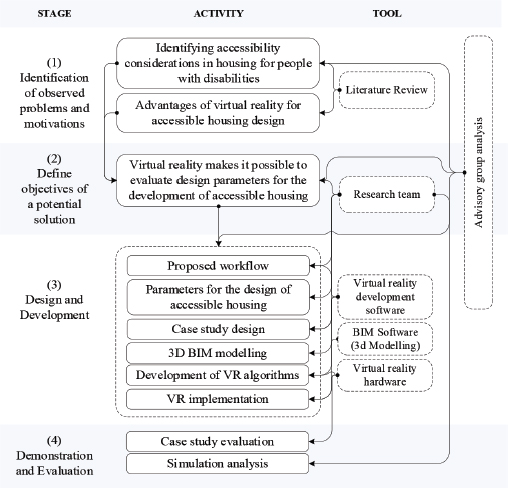
In the first stage, aspects related to the design of accessible housing were identified. These have been considered based on architectural regulations and specific aspects of the needs of people with disabilities. Along with this, the advantages and potential of virtual reality for the design of accessible homes were identified. Thus, in the second stage, the objective of a potential solution was defined: Virtual reality makes it possible to evaluate design parameters for the development of accessible housing.
In the third stage, Design and Development, a workflow for using virtual reality in the design of accessible homes was proposed. Parameters for designing such homes were identified. A case study was designed to demonstrate the reliability of the proposals. Thus, an accessible home (in accordance with the studied regulations) was modelled. Algorithms and scenarios were developed in virtual reality environments to generate an immersive setting replicating the required actions of a family home. The case study was then implemented.
In the fourth stage, Demonstration and Evaluation, the case study was tested using virtual reality headsets by a test group. The case study was evaluated and analyzed to reflect on the usefulness of the methods, applications, and areas for improvement.
The four stages of this study were designed under the framework of the inclusive research paradigm (Walmsley et al., 2018). Adopting an inclusive research model entails ensuring the participation of people with disabilities in various stages of the research processes that concern them. In this study, we have chosen to implement one of the approaches suggested in the literature to facilitate the participation of these individuals in research pertinent to them: forming advisory groups with decision-making power that work collaboratively with the researchers throughout the entire process (Bigby et al., 2014) (Figure 1).
To form the advisory group, three disability service organizations in the Valparaíso region of Chile were contacted. Once the advisory team was established, consisting of nine adults with intellectual and/or physical disabilities, an initial meeting was arranged at the university premises. During this meeting, the purpose of the research and the tasks involved were explained to them. After signing informed consent forms, monthly work sessions (three-hour meetings) were scheduled until the completion of the research. The execution of the study phases allowed for the consolidation of certain roles in this process. The advisory group members evolved from learners to informants, experts by experience, and finally to co-researchers.
3. Findings
The research design has centered on creating a demonstrator for the proposed concept. The focus has been restricted to examining accessible housing access zones as an initial step in analyzing this category of housing. Its significance lies specifically in the recognition that access areas to housing play a crucial role in granting individuals with disabilities autonomy during their initial interaction with their residence. Moreover, the development has been confined to addressing physical disabilities. It is important to note that other disability types, such as cognitive or sensory impairments, necessitate additional scrutiny and the examination of other relevant variables.
3.1. Parameters for the design of accessible housing
Various countries have distinct regulations governing the architectural considerations and dimensions of residential structures. While the specific values for various housing design parameters vary in each standard, the underlying considerations share similarities. Primarily, these regulations aim to facilitate access for individuals with disabilities, particularly those who use wheelchairs. Consequently, for the purposes of this research, the Chilean standard; Decreto Supremo - DS N.°49 (Biblioteca del Congreso Nacional de Chile, 2023), has been utilized as an initial reference for housing design. Table 1 shows the different parameters to be considered in accessible housing access zones.
Tabla 1. Parameters for accessible housing (Chilean regulations DS n.° 49)
TYPE |
PARAMETER |
Minimum value (m) |
Parameter Analysis |
Doors |
Clear width (AL-P) |
0.9 |
Independent, fixed value |
Impact height (AI-P) |
0.3 |
Independent, fixed value |
|
Door handle height (AM-P) |
0.9 |
Independent, fixed value |
|
Ramp |
Length (L-R) |
1.5 |
Variable and depends on slope |
Slope (P-R) |
12% |
Value variable |
|
Clear width (AL-R) |
0.9 |
Independent, fixed value |
|
Maneuvering Area |
Clear Diameter (DL-ZM) |
1.5 |
Independent, fixed value |
Free area (AL-ZM) |
1.5 x 1.5 |
The width of the area is variable; therefore, the value of the area is dependent on this parameter |
|
Handrails |
Handrail height (AP-B) |
0.7-0.95 |
Depends on the location, values are unique |
The regulations establish specific requirements for the construction of housing with accessible entry points for people with disabilities, which include:
- Accessibility from public space to the entrance door. Dwellings must be accessible through an obstacle-free route from public space to the entrance door. The accessible route must be paved and have a minimum width of 90 cm.
- Level difference between the entrance area and the sidewalk. In the case of a level difference between the entrance area and the sidewalk, a ramp must be installed in compliance with the regulations of the General Urban Planning and Construction Ordinance (OGUC).
- Space at the end of the ramp in front of a door. If the ramp ends in front of a door, a flat space without slope must be provided. This space must have a minimum dimension of 150 x 150 cm to allow for the maneuvering of door opening and wheelchair entry.
- Handrails in case of stairs. If handrails are installed, they must be continuous and of double height. The first height should be 95 cm, and the second should be 70 cm. The handrails must extend at least 20 cm beyond the entry and exit points of the ramp.
- These requirements aim to ensure that housing intended for individuals with disabilities is accessible and functional, enabling safe and comfortable mobility, while also facilitating access to the residence and the use of its facilities.
3.2. Case study description
For the case study where the simulation will be implemented, a 60 m2, one-storey, single-family house has been considered. It has been designed according to the current Chilean regulations for accessible housing (physical disability). Figure 2 shows the parameters considered and the situations to which the people who will carry out the simulation will be subjected. In this way, the virtual reality simulation is intended to be a tool for the early identification of accessibility problems and the optimization of the design before the physical implementation of the project.
Figura 2. Simulated Parameters and Situations
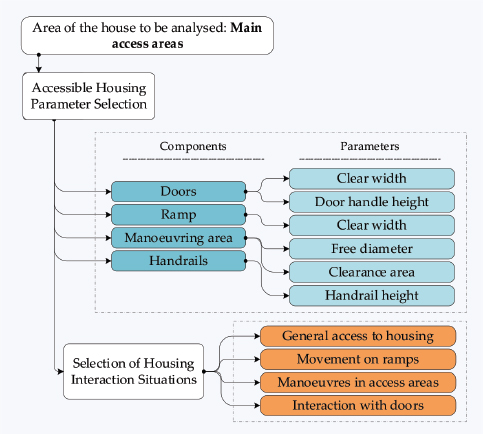
The virtual reality development will selectively focus on specific parameters related to the main accessibility of an accessible dwelling. These parameters have been identified as critical to ensure accessibility and will therefore be subject to a thorough evaluation. This detailed analysis will be carried out by taking advantage of advanced technologies such as virtual reality and BIM methodology for 3D modelling of the dwelling. The parameters for accessibility that will be thoroughly assessed will be: Doors (Clear Width, Door Handle Height), Ramp (Clear Width), Maneuvering Area (Clear Diameter, Clear Area), and Handrails (Handrail Height). This selective approach will allow a precise dedication to the essential aspects that ensure the suitability of the dwelling for the needs of people with physical disabilities.
On the other hand, various situations will be simulated in the virtual reality environment. The simulation situations cover a variety of scenarios faced by a person with a disability, representing the challenges to achieve independent living in the context of the home. Consideration has been given to:
Access to the dwelling: Assessment of accessibility from the public space to the entrance door, considering the clear width, handle height and any potential obstacles.
- Ramp travel: Simulation of the ramp travel experience, assessing the clear width and ensuring that it meets established standards.
- Maneuvering in access areas: Assessment of the ease of maneuvering in specific areas, considering the diameter and clearance area required for wheelchair turns and movements.
- Interaction with doors: Simulation of the opening of doors, verifying the presence of adequate flat spaces to facilitate the opening maneuvers and wheelchair entry.
Each situation has been designed with the aim of evaluating the effectiveness of the design in terms of the regulations considered, highlighting areas of compliance and possible improvements.
3.3. 3D BIM modelling
The accessibility parameters and situations considered have been implemented in a 3D model of an accessible dwelling, which has been developed in strict compliance with current regulations. Figure 3 shows the modelling process of a house from 2D drawings to a parametric 3D BIM model, whose dimensions can be modified according to multiple design requirements in a semi-automatic way. This BIM (Building Information Modelling) approach guarantees a faithful and accurate representation of the architectural and structural reality of the house.
Figura 3. 3D modeling
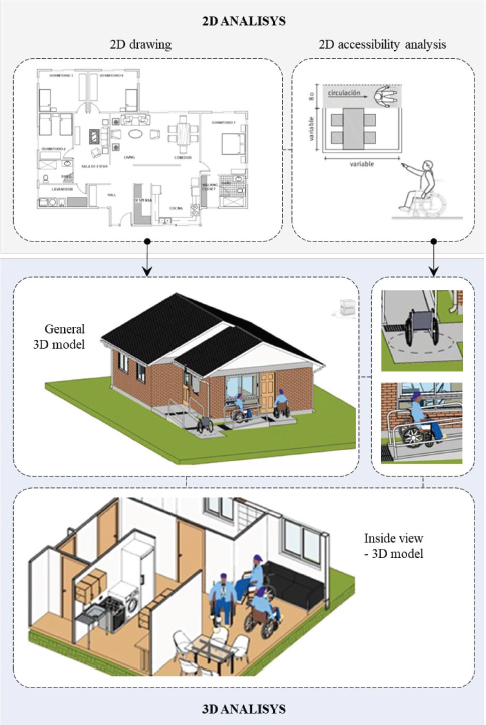
On the other hand, Figure 4 shows the income options that housing allows. These are two: a main entrance door (front of the house) and a secondary entrance through the kitchen area (side of the house). The Figure also shows the possible routes that people will take to enter the house.
Figura 4. 3D modeling: Main and secondary access
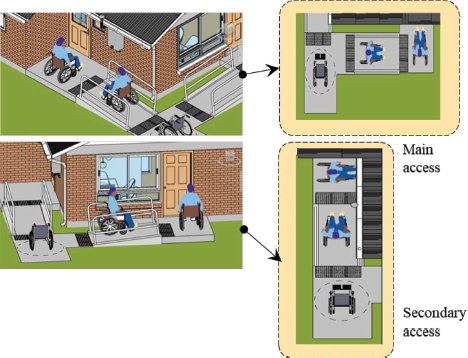
These two scenarios have been selected as situations to address different access points, allowing for a comprehensive assessment of accessibility in different areas of the dwelling. This strategy will ensure that both the main access and any secondary entrances are compliant and provide a suitable living environment for people with disabilities. Virtual reality simulation will be key to identify possible improvements and optimise the design prior to physical implementation.
3.4. Virtual Reality developments
A neighbourhood setting was developed in virtual reality to position the accessible housing according to the typical conditions of the designed residence. The BIM model of the house was imported into the VR development environment (Unity 3D), incorporating elements such as sky, light, trees, fences, lampposts, grass, among others. All these elements significantly enhance the immersion of the person experiencing the simulation (see Figure 5).
Figura 5. 3D house model in a realistic virtual reality environment. (a) General view of the house; (b) Front view of the front of the house; (c) General view of the surroundings of the house
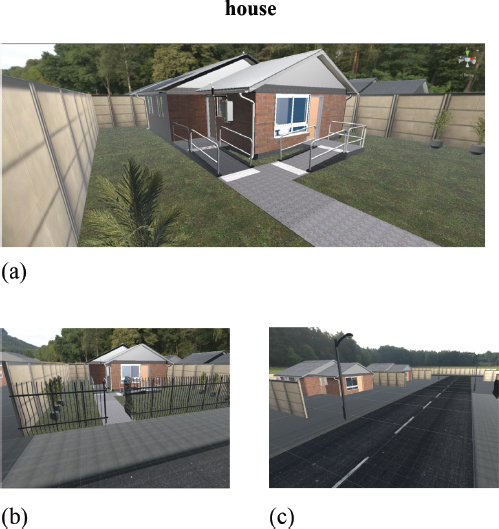
After reconstructing the scene, an avatar and wheelchair with the animation of a seated person are imported. This way, the avatar is placed in the wheelchair. Then, a copy of the avatar is created, where the first one will contain the entire torso, and the copy will only contain the legs. Figure 6 shows the avatar and the elements considered for simulating the person who will navigate through the house.
Figura 6. Avatar and wheelchair simulator
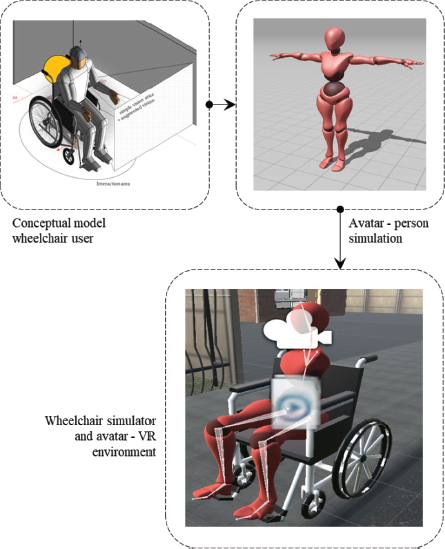
Within the key aspects that generate immersion in virtual reality, interactions with the environment play a crucial role. Considering that the evaluation focuses on main accessibility parameters, the elements with which one can interact the most are doors and handles. Therefore, it is necessary to implement interactions that mimic those of a real door. Now, one must also consider the interaction of the virtual hand controlled by the virtual reality headset controller with the door handle. This can be achieved through code (script). Consequently, each time the synthetic hand interacts with the handle, the handle rotates 30° downward, simulating a real-world movement. Additionally, a separate interaction is added to allow pulling or pushing the handle, causing the door to rotate around the hinge pivot. After unifying the entire environment in virtual reality, there is still no tool available to evaluate parameters. Figure 7 shows an example of the colliders that give the physics to the door.
Figura 7. Colliders example: Door
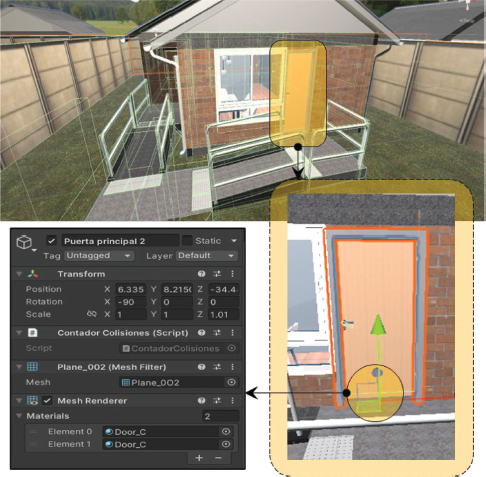
With the environment and interactions already implemented, the next step is to define a monitoring tool like surveillance cameras. This tool examines perspectives of interest that assess the scene and, consequently, the housing parameters. Twelve different perspectives are considered: eight of these can evaluate doors, two can assess the environment, another camera tracks the movement of the person experiencing the simulation, and one provides a "bird’s-eye view," allowing a view of the model, trajectory, and movements within the environment.
On the other hand, two other cameras enable the creation of a heat map through a perspective that displays the infrared scene with a visible grid, providing a top-down view. One of these views shows the entire environment where the person will interact, while the other focuses closely on the person’s movements. This setup allows the observation of door opening attempts, the number of collisions, passage through areas with fall risks, time spent in each zone, and decision-making regarding the trajectory. In this way, the tool is equipped to address and evaluate all the defined parameters in the established simulation scenarios. Figure 8 displays all the implemented cameras and the simulation monitoring panel.
Figura 8. Simulation monitoring panel
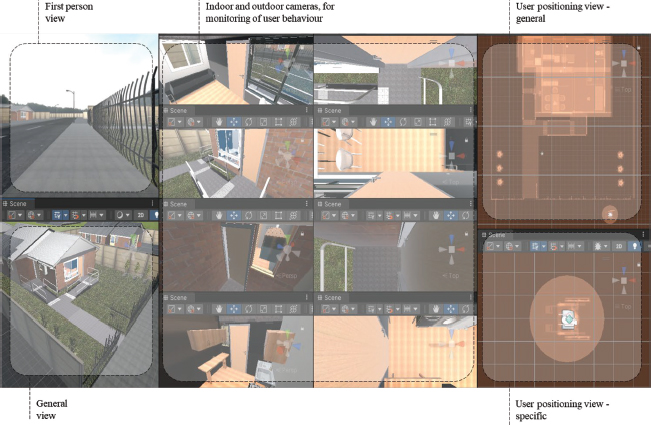
3.5. Advisory group analysis
The work with the advisory group consisted of three phases. In the training phase, through a series of workshops, the advisors acquired skills to navigate the different stages of a research project. They also discussed topics related to the concept of accessible housing and its implications.
During the execution phase, the use of prosocial visualization techniques and mood boards (Endrissat et al., 2016) allowed the advisory group to delve deeper into the various topics addressed. In this research, prosocial visualization and mood boards served as tools to support verbalization and the elicitation of personal narratives, enabling the collection of more focused and semantically rich discourse (Figure 9). The outcomes of working with these techniques facilitated the identification of priority areas for the development of accessible housing, based on the perceptions of the individuals themselves, which were used as a reference for the continuous development and refinement of the virtual reality environment.
Figura 9. Example of an advisory group analysis activity

In the analysis phase, the advisory group contributed to the evaluation of the final design of the virtual reality housing (shapes, colors, sizes, etc.). They also participated in discussing the results and extracting practical conclusions and implications through a focus group. Throughout the process, the advisory group received support from specialized personnel and had access to cognitively accessible materials.
4. Demonstration and evaluation
The research design has centered on creating a demonstrator for the proposed concept. The focus has been restricted to examining accessible housing access zones as an initial step in analyzing this category of housing. Its significance lies specifically in the recognition that access areas to housing play a crucial role. An initial demonstration was conducted with team members.
Figure 10 captures a moment where the user is attempting to open a virtual door. The inclination gesture and corresponding actions are visible, along with the monitoring panel to track all their movements. Additionally, it displays a heat map detailing the trajectory that a user follows through the access areas of the residence. In the figure you can see different boxes with numbers on a gridded map, showing points on the trajectory plane of a user. The values in the boxes represent the dwell time (in seconds) of the users using the virtual reality simulation. Thus, for the example shown, the green areas with a value of zero correspond to places where the user has not been. Thus, the other values show dwell times of up to 32 seconds in one place (red zone), which represents longer static times in those places performing some action in the house. In yellow, it shows where the user has spent less time, and in red, more time. In other words, it indicates where the user takes more time to perform an action. It is notable that the areas in front of the main entrance door and behind the kitchen’s side door are where the person has spent more time.
Figura 10. Example demonstration, simulation work setup, and trajectory heat-map
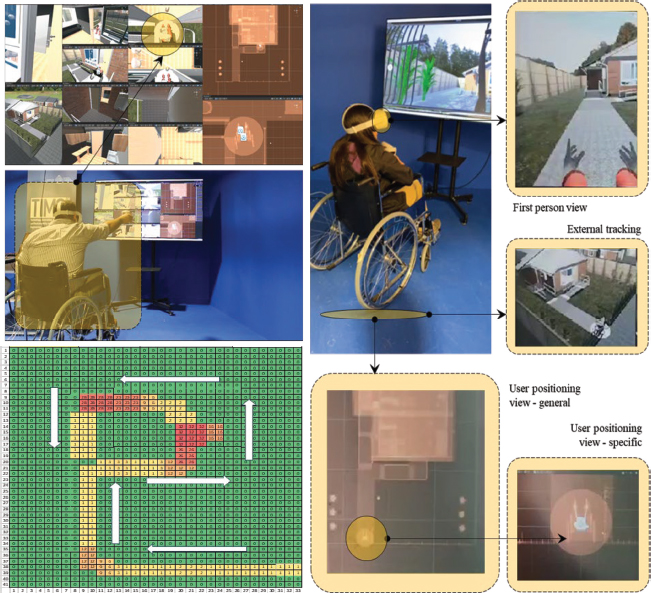
In this initial evaluation, the use of heat maps and cameras to track user behavior stands out, which helped determine the time they tended to stay, several possible falls were obtained from users who inadvertently passed through unestablished areas, affecting the maneuver area.
5. Conclusion
Currently, the right to independent living is a pending challenge in the field of disability that must be responded to shortly. Precisely, for people with disabilities, the realization of the right to independent living involves the enjoyment of their own, dignified, and adequate housing. Although there are some initiatives that promote the design of accessible housing, these do not necessarily meet the needs of people with different types of disabilities: cognitive, physical, and sensory.
Along these lines, virtual reality offers an innovative scenario that allows identifying accessibility parameters aimed at housing design, extrapolated to the real scenarios in which people with disabilities operate. Likewise, virtual reality, due to its characteristics, becomes the most suitable digital tool to encourage the participation of people with disabilities themselves in the process of defining standards or parameters designed for the design of accessible housing that meets the felt needs of this person. population. In particular, the evaluation of primary access parameters in accessible housing is essential to ensure the inclusion and comfort of people with physical disabilities.
The proposed tool, despite offering a degree of realism in some aspects, must continue to be developed. Elements of the analysis must be incorporated, aspects such as fluidity in movements and the implementation of shadows in the lights to prevent the person from focusing too much on the environment and perceiving it as if it were a real house. In addition, the tool was designed to allow the evaluation of specific main access parameters, such as door handles. Other aspects can be considered to address other types of entry to the home. The evolution and refinement of this tool are essential to ensure more accurate and exhaustive evaluations of the main access parameters in accessible housing. Only through continuous improvements and adaptations to the specific needs of users will it be possible to guarantee an inclusive and accessible environment for all.
The possibilities of virtual reality for the evaluation of accessible housing design allow reducing costs and iteration times in the design and analysis processes of products (new or in the process of renovation). And with this, improve these processes, with the digital and immersion tools themselves, including a greater number of interested parties and relevant actors, favoring collaborative development, not only of the technical team, but also of the end users (the direct stakeholders), but who often turn out to be the losers of non-inclusive design processes).
6. Acknowledgements
This research was supported by the ANID Millennium Science Initiative Program (ICS2019_024) and by the Project DI Interdisciplinary associative research PUCV 2023 (039.352/2023) of the Pontificia Universidad Católica de Valparaíso (Chile).
7. Bibliographical references
Atack, L., Verseghy, J., Maher, J., Herie, M., Poirier, M., MacNeil, F. and Grimley, M. (2019). An emerging model for semi-independent living for persons with intellectual and developmental disabilities. Inclusion, 7(1), 57-70. https://doi.org/10.1352/2326-6988-7.1.57
Biblioteca del Congreso Nacional de Chile. (2023). Decreto Supremo 49: Bases administrativas generales para contratos de diseño y ejecución de obras que celebren los servicios de vivienda y urbanización. https://www.bcn.cl/leychile/navegar?idNorma=1196644&idVersion=2023-10-06
Bigby, C., Frawley, P. and Ramcharan, P. (2014). A collaborative group method of inclusive research. Journal of Applied Research in Intellectual Disabilities, 27(1), 54-64.
Boje, C., Guerriero, A., Kubicki, S. and Rezgui, Y. (2020). Towards a semantic construction digital twin: Directions for future research. Automation in Construction, 114, 103179. https://doi.org/10.1016/j.autcon.2020.103179
Budziszewski, P., Grabowski, A., Milanowicz, M. and Jankowski, J. (2016). Workstations for people with disabilities: An example of a virtual reality approach. International Journal of Occupational Safety and Ergonomics, 22(3), 367-373.
Ceccacci, S., Germani, M. and Mengoni, M. (2012). User-centered approach for home environment designing. In ACM International Conference Proceedings Series. https://doi.org/10.1145/2413097.2413136
Dew, A., Collings, S., Dillon, I., Gentle, E. and Douse, L. (2019). ‘Living the life I want’: A framework for planning engagement with people with intellectual disability and complex support needs. Journal of Applied Research in Intellectual Disabilities, 32(2), 401-412. https://doi.org/10.1111/jar.12538
Di Gironimo, G., Matrone, G., Tarallo, A., Trotta, M. and Lanzotti, A. (2013). A virtual reality approach for usability assessment: Case study on a wheelchair-mounted robot manipulator. Engineering with Computers, 29, 359-373. https://doi.org/10.1007/s00366-012-0274-x
Dimitriadou, I. (2020). Independent living of individuals with intellectual disability: A combined study of the opinions of parents, educational staff, and individuals with intellectual disability in Greece. International Journal of Developmental Disabilities, 66(2), 153-159. https://doi.org/10.1080/20473869.2018.1541560
Dozio, N., Marcolin, F., Scurati, G. W., Ulrich, L., Nonis, F., Vezzetti, E., Marsocci, G., La Rosa, A. and Ferrise, F. (2021). A design methodology for affective virtual reality. International Journal of Human-Computer Studies, 162, 102791. https://doi.org/10.1016/j.ijhcs.2022.102791
Endrissat, N., Islam, G. and Noppeney, C. (2016). Visual organizing: Balancing coordination and creative freedom via mood boards. Journal of Business Research, 69(7), 2353-2362.
Getuli, V., Capone, P. and Bruttini, A. (2020). Planning, management, and administration of HS contents with BIM and VR in construction: An implementation protocol. Engineering, Construction and Architectural Management, 28(2), 603-623. https://doi.org/10.1108/ECAM-11-2019-0647
Kaklanis, N., Moschonas, P., Moustakas, K. and Tzovaras, D. (2013). Virtual user models for the elderly and disabled for automatic simulated accessibility and ergonomics evaluation of designs. Universal Access in the Information Society, 12(4), 403-425. https://doi.org/10.1007/s10209-012-0281-0
Kamieth, F., Dhne, P., Wichert, R., Luis, J., Jimenez-Mixco, V., Arca, A., and Teresa, M. (2010). Exploring the potential of Virtual Reality for the elderly and people with disabilities. InTech. https://doi.org/10.5772/13591
Kang, S. and Kang, S. (2019). The study on the application of virtual reality in adapted physical education. Cluster Computing, 2351-2355. https://doi.org/10.1007/s10586-018-2254-4
Malik, K. and Mikolajczak, E. (2019). Senior housing universal design as a development factor of a sustainable-oriented economy. Sustainability (Switzerland), 11(24). https://doi.org/10.3390/su11247093
Martínez, O. (2022). Viviendas para personas con discapacidad intelectual: habitarlas desde la interioridad. Actas de Coordinación Sociosanitaria,(30), 82-99.
Mourtzis, D., Panopoulos, N., Angelopoulos, J., Wang, B. and Wang, L. (2022). Human-centric platforms for personalized value creation in the metaverse. Journal of Manufacturing Systems, 65, 653-659. https://doi.org/10.1016/j.jmsy.2022.11.004
Muñoz-La Rivera, F., Mora-Serrano, J., Valero, I. and Oñate, E. (2021). Methodological-Technological Framework for Construction 4.0. Archives of Computational Methods in Engineering, 28(2). https://doi.org/10.1007/s11831-020-09455-9
Otamendi, N. and Navas, P. (2018). Calidad de vida de personas con discapacidad intelectual en proceso de envejecimiento en entornos de vivienda. Revista Española de Discapacidad, 6(2), 27-47.
Raimbaud, P., Lou, R., Danglade, F., Figueroa, P., Hernandez, J. T. and Merienne, F. (2021). A task-centered methodology to evaluate the design of virtual reality user interactions: A case study on hazard identification. Buildings, 11(7). https://doi.org/10.3390/buildings11070277
Roque, P. and Crespillo, L. (2022). O Grupo do Leão, una nueva visualidad de acceso: una propuesta metodológica en torno al uso de la realidad virtual en personas con discapacidad visual. Arte, Individuo y Sociedad, 35(1), 29-51. https://doi.org/10.5209/aris.80509
Ryan, J. B., Randall, K. N., Walters, E. and Morash-MacNeil, V. (2019). Employment and independent living outcomes of a mixed model post-secondary education program for young adults with intellectual disabilities. Journal of Vocational Rehabilitation, 50(1), 61-72. http://doi.org/10.3233/JVR-180988
Sheerin, F., Griffiths, C., De Vries, J. and Keenan, P. (2015). An evaluation of a community living initiative in Ireland. Journal of Intellectual Disabilities, 19(3), 266-281. https://doi.org/10.1177/1744629515573679
Walmsley, J., Strnadová, I. and Johnson, K. (2018). The added value of inclusive research. Journal of Applied Research in Intellectual Disabilities, 31(5), 751-759.
Yu, E., and Choi, J. (2023). Development of building information modeling-based automation assessment process for universal design of public buildings. Journal of Computational Design and Engineering, 10(2), 641–654. https://doi.org/10.1093/jcde/qwad018
_______________________________
1 Autor de correspondencia.